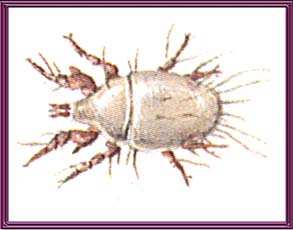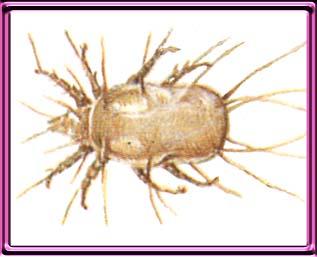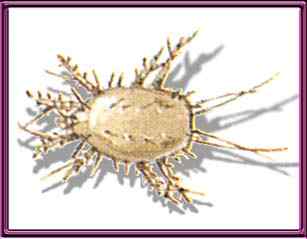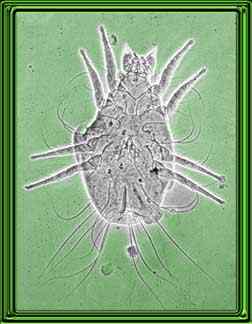
Acarus
siro
(Flour Mite)
(Flour Mite)
Mites and ticks belong in the phylum Chelicerata, class Arachnida, order Acarina.
This is the commonest species (see above) of mite in foodstuffs; it has reddish/pinkish legs. Flour mites can live in almost any type of flour or in fodder and, not least important, in stores of seed or corn. They are also to be found on old cheese. A single female can lay up to 500-800 eggs in her lifetime at a rate of 20-30 a day.
After hatching the life cycle consists of a larval stage, two so-called nymphal stages and the adult stage, which at 25°C is reached in three weeks. These mites can go through their life cycle at a temperature as low as 0-4°C, but they do require adequate humidity, and will not thrive if the relative humidity is less than 65% as they will desiccate. The entire life cycle may take only nine to eleven days to complete under the optimal conditions of 90% humidity and 77° F. The life cycle is completed in seventeen days at 64-71°F, and twenty-eight days at 50-60° F. Flour mites are able to withstand periods where the conditions are unfavourable. After the second nymphal stage they may pass into what is known as hypopus stage which is a diapause form, in which they are almost immobile and very resistant to desiccation. In the hypopus stage, the body wall hardens and suckers appear on the underside. These suckers allow the mite to attach to insects and other animals for dispersal. The eggs and especially the hypopuses appear to be more tolerant of insecticides than other juveniles or adults; and they may be the primary stage responsible for resurgences in mite populations after chemical control appeared to have been successful.
Flour or grain mites are pale, pearly or greyish white, with legs varying in colour from pale yellow to reddish-brown. Each leg has one claw at the end. As with all mites, they are smooth, wingless, soft-bodied creatures. The males are from 0.013 to 0.017 inch long, and the female is from 0.014 to 0.026 inch. The males have enlarged forelegs which bear a thick spine on the ventral side. These two characters can be used to separate Acarus sp. from other genera. Juvenile mites are similar in appearance to the adults. The first or larval stage has only six legs. However, when they moult into the nymphal stage, they have eight legs like the adults. Mite eggs are oval, smooth, white, and are 0.12 mm long
If there is any doubt as to whether flour is infested with mites it is only necessary to spread a little out on a table and leave it for quarter of an hour. If the mites are present the surface of the flour will become uneven as the mites start to wander about.
Mite infested foodstuffs acquire a sickly sweet smell and a taste which renders them unsuitable for human consumption. Heavily infested products are definitely injurious and should be discarded. Heavily infested grain and feed that has become tainted and unpalatable as animal feed. When fed infested commodity, small companion animals (e.g., dogs) can show reduced feed intake, diarrhoea, inflammation of the small intestine, and impaired growth. Pigs that consume mite-infested feed have their live-weight gain, feed:gain ratio, and nitrogen retention markedly reduced.
The only effective method of controlling mites is to ensure that the foodstuff in question is stored as dry and as cool as possible. Failing this fumigation will have to be considered. Because of the higher tolerance of mite eggs to fumigation, the concentration of gas introduced will need to be fifty percent greater than that for insect control. Fumigants are highly toxic, and technical knowledge is required for their proper use. A qualified, licensed pesticide applicator should be contacted to perform the fumigation.

Tyrophagus
casei
(Cheese Mite)
(Cheese Mite)
Cheese mites can also live in corn, flour, etc., but they are best known for their occurrence in cheese, in which they gnaw small holes. These cosmopolitan mites are common in stored food, damp flour, old honeycombs, and insect collections. A ripe, mite-infested cheese will be more or less covered with a grey powder, which consists of the mites themselves and their moulted skin and faeces. Cheese mites can live at low temperatures but not in the refrigerator. For many cheeses the presence of mites is highly undesirable, but there are some cheeses in which a culture of cheese mites is introduced for example to Altenburger cheese to impart a characteristic "piquant" taste. When the cheese is covered with a greyish powder, consisting of enormous numbers of living and dead mites, cast skins, and faeces, it is considered by some people to be "ripe" and particularly delectable. Cheese can be protected by a thin layer of paraffin wax.The cheese mite, known to cause dermatitis, is larger than both the grain mite and the mould mite. It has stout, well-tanned, faintly-wrinkled legs (obviously been on holiday) and tanned mouthparts. Males and females are similar except that females are larger. The life cycle requires 15 to 18 days at the ideal temperature of 73°F and an Relative Humidity of 87%. Unlike the grain mite the hypopus stage does not occur in the cheese mite.

Carpoglyphus
lactis
(Prune Mite)
(Prune Mite)
This little chappie is very similar to the flour mite (Acarus siro) and it also has pinkish legs, but it can be distinguished, amongst other things, by the fact that it's body is not divided into two by a transverse line. These mites live mainly in dried fruit, and sometimes in jam. People who suffer with mite-infested goods may suffer from an eczema-like condition because they become sensitised to the mites and to their moulted skin and faeces. Prune mites are particularly likely to produce this type of condition, often known as 'grocers itch', but flour mites and mould mite may also be responsible.

Tyrophagus
putrescentiae
(Mould Mite)
(Mould Mite)
Mould mites are very common but usually go unnoticed except in occasions when they become abundant. They can infest stored food and grain and cause tremendous losses although they are more usually an annoyance and nuisance and not injurious. They are harmless to people and pets, furniture, house structures, clothing and so forth. Mould mites only develop where there is moisture or a high humidity. As the name implies, they feed on moulds and are common only where mould and fungi can flourish. They have been reported from a large number of items and places but the common characteristic of all infestations is the presence of a high humidity. Infestations have been mentioned in cheese, flour, grain, seeds, bulbs, straw, wallpaper, furniture, dried fruits, cereal foods, bird and small mammal nests and so forth.